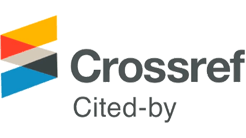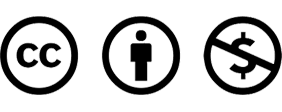-
Article Review
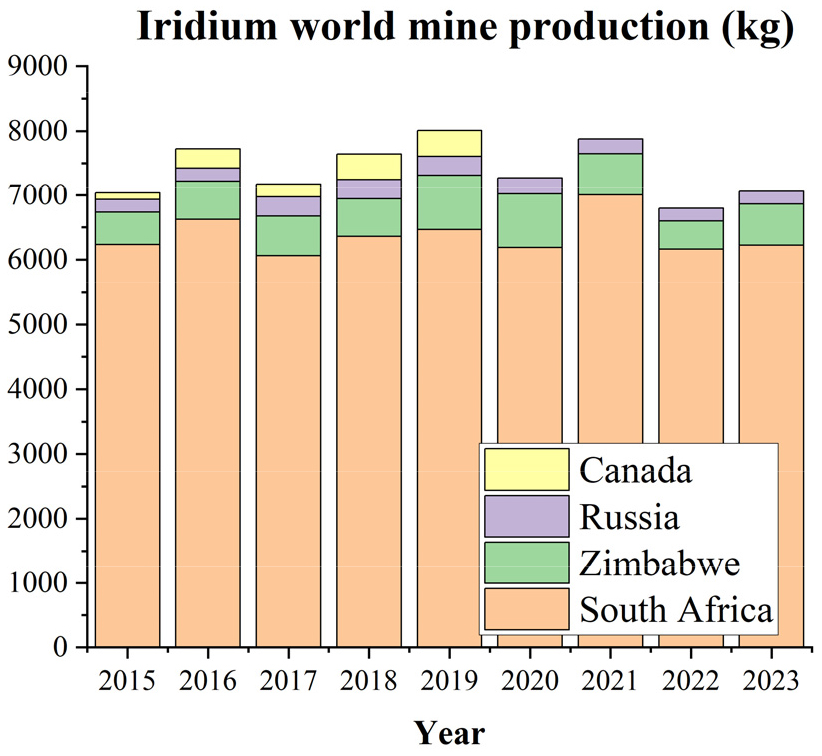
-
A Short Review on Hydrometallurgical Recovery of Iridium
이리듐의 습식제련 기반 회수 기술에 대한 문헌 연구
-
Hyein Kim, Junmo Ahn
김혜인, 안준모
- Ir is widely used in various industries, including chemical and electronics industry, owing to its high corrosion and heat resistance. The importance …
이리듐(Iridium, Ir)은 우수한 내식성, 내열성의 특성이 있어 첨단 산업에서 주로 이용되고 있다. 최근 그린 수소 생산에 대한 수요가 증가와 함께 이리듐의 수요 …
- Ir is widely used in various industries, including chemical and electronics industry, owing to its high corrosion and heat resistance. The importance of Ir as a catalyst in proton exchange membrane electrolyzers has increased with the growing demand for green hydrogen, necessitating the recycling of secondary Ir sources, particularly owing to the scarcity of Ir and its high cost. Domestic research on hydrometallurgical recovery of Ir is limited in South Korea. This paper reviews international case studies of hydrometallurgical methods for the recovery of Ir from various Ir-containing resources. In addition, the literature concerning overseas PGMs (Platinum Group Metals) refining processes, including Ir separation, is reviewed.
- COLLAPSE
이리듐(Iridium, Ir)은 우수한 내식성, 내열성의 특성이 있어 첨단 산업에서 주로 이용되고 있다. 최근 그린 수소 생산에 대한 수요가 증가와 함께 이리듐의 수요 또한 증가하고 있다. 특히 이리듐이 촉매로 사용되는 PEM(Proton exchange membrane) 전해조의 용량 확장이 요구되면서 Ir의 중요성이 더욱 부각되고 있다. 이리듐은 PEM 전해조 외에도 다양한 산업 분야에서 활용되고 있으나, 그 희소성과 높은 가격으로 인해 2차 금속 자원에서의 이리듐 회수를 위한 재활용 기술이 필수적이다. 하지만 국내 이리듐의 습식제련을 이용한 재활용 연구가 미비한 실정이다. 이에 본 논문은 이리듐 자원으로부터 이리듐 회수를 위한 습식제련(침출, 용매추출)에 대한 해외 연구 사례를 조사하였다. 또한 상업적 PGM 정제 공정의 이리듐 회수 사례를 조사하였다.
-
A Short Review on Hydrometallurgical Recovery of Iridium
-
Article Review
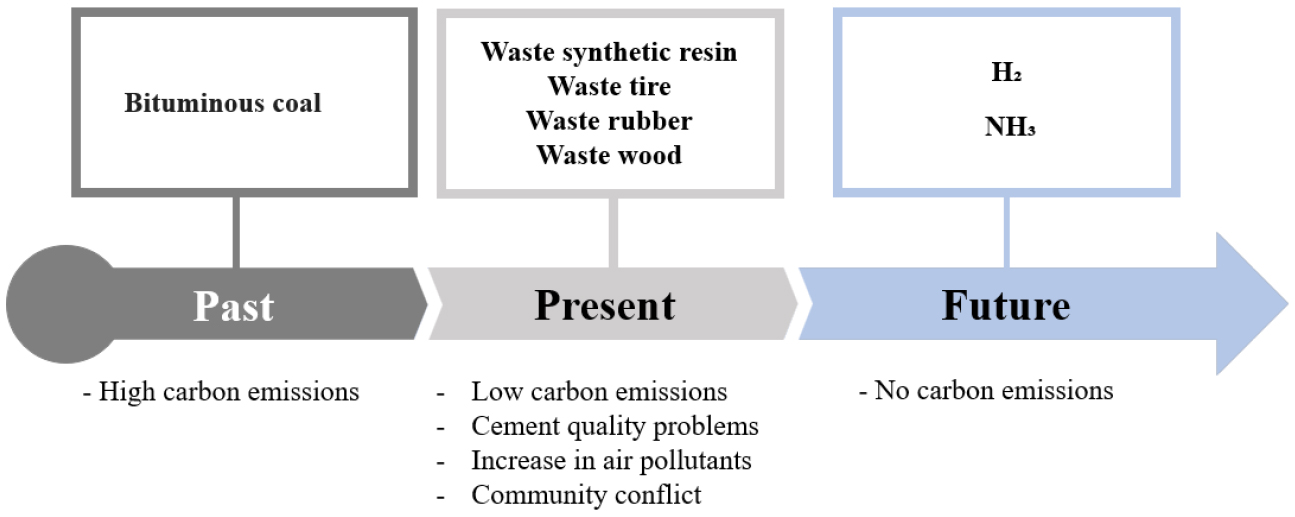
-
Analysis of Alternative Fuels for Carbon Reduction in the Cement Industry
시멘트 산업의 탄소 저감을 위한 대체연료 분석
-
Na-yeong Kim, Young-jin Kim, Tae-hyung Kim, Jin-sang Cho
김나영, 김영진, 김태형, 조진상
- The cement industry is an energy-intensive sector with significant CO2 emissions owing to the high-temperature calcination processes and fuel combustion involved …
시멘트 산업은 고온 소성 공정을 수반하는 에너지 집약적 산업으로, 원료의 탈탄산 반응 및 연료 연소 과정에서 다량의 이산화탄소를 배출한다. 탄소중립 실현이 가속화됨에 …
- The cement industry is an energy-intensive sector with significant CO2 emissions owing to the high-temperature calcination processes and fuel combustion involved in clinker production. As the realization of carbon neutrality accelerates, the introduction of fuels to replace existing fossil fuels is being deliberated for the cement sector. In the domestic cement industry, various waste-derived alternative fuels, such as waste synthetic resins, waste tires, and waste wood, are utilized. This can contribute to the reduction of greenhouse gas emissions and promote resource recycling. As of 2021, the domestic cement industry has used approximately 2.245 million tons of the alternative fuels, accounting for 35 % of the total fuel consumption in the cement industry. Alternative fuels emit lower CO2 than fossil fuels, such as bituminous coal. However, the domestic utilization rate of alternative fuels is low compared to that of major European countries. Accordingly, a multifaceted approach, includes institutional improvement, quality control, and supply and demand stabilization is required. This study investigated the current status of alternative fuel use in the domestic cement industry, overseas applications, and the characteristics of each fuel. Additionally, it explored ways to utilize carbon-free fuels such as hydrogen and ammonia to realize carbon neutrality in the cement industry in the future.
- COLLAPSE
시멘트 산업은 고온 소성 공정을 수반하는 에너지 집약적 산업으로, 원료의 탈탄산 반응 및 연료 연소 과정에서 다량의 이산화탄소를 배출한다. 탄소중립 실현이 가속화됨에 따라, 시멘트 산업에서는 기존의 화석연료를 대체할 수 있는 연료의 도입이 중요한 과제로 논의되고 있다. 국내 시멘트 산업에서는 폐합성수지, 폐타이어, 폐목재 등 다양한 폐기물 기반 대체연료가 활용되고 있으며, 이는 자원순환 촉진과 동시에 온실가스 저감에 기여할 수 있다. 2021년 기준, 국내 시멘트 산업의 대체연료 사용량은 약 2,245천 톤으로, 전체 연료 사용량의 35%를 차지하는 것으로 보고되었다. 대체연료는 기존 연료인 유연탄에 비해 이산화탄소 발생률이 적다는 장점이 있지만, 국내의 대체연료 활용률은 유럽 주요국에 비해 낮은 수준에 머물러 있다. 이에 따라 제도적 개선, 품질관리, 수급 안정화 등 다각적인 접근이 요구된다. 본 연구에서는 국내 시멘트 산업에서의 대체연료 사용 현황, 해외 적용 사례, 연료별 특성 등을 조사하였으며 향후 시멘트 산업의 탄소중립을 위한 수소와 암모니아 같은 무탄소연료의 활용 방안을 모색하였다.
-
Analysis of Alternative Fuels for Carbon Reduction in the Cement Industry
-
Article Review
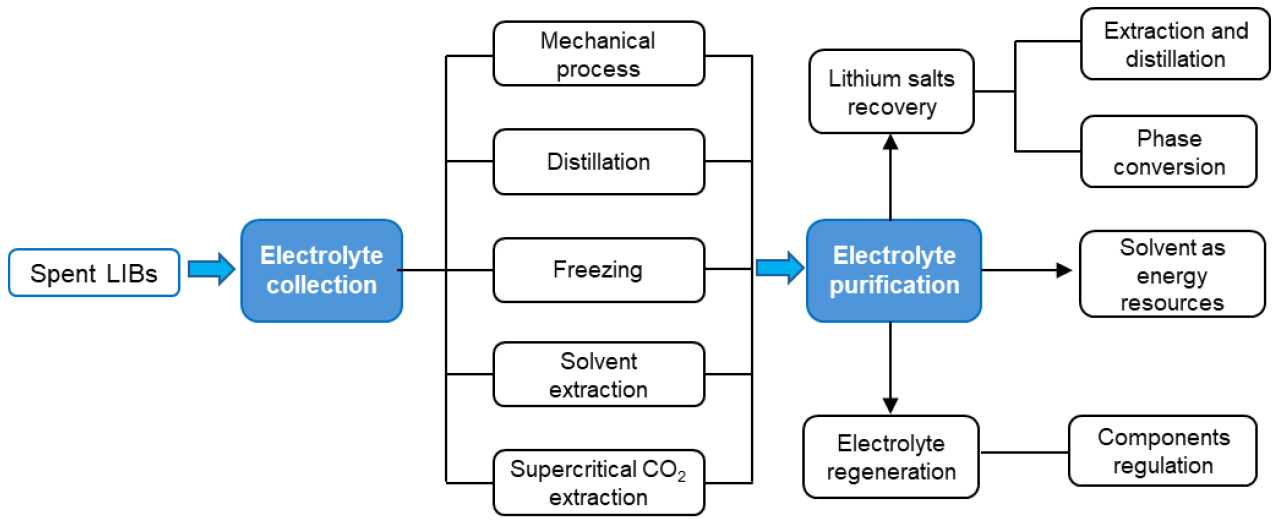
-
Analysis of Electrolyte Recycling Technology from Spent Lithium-Ion Batteries(LIBs)
폐 리튬이온전지(LIB) 전해액 재활용 기술 분석
-
Jaewoo Ahn, Junhee Kim, Jaehyuk Chang, Minhyuk Seo, Youngjae Lee
안재우, 김준희, 장재혁, 서민혁, 이영재
- Recycling electrolytes from spent lithium-ion batteries(LIBs) is a critical step toward sustainable resource management and environmental protection. Electrolytes, consisting of organic solvents …
폐 리튬이온전지(LIB)에서 전해질을 재활용하는 것은 자원 순환과 환경 보호를 위한 핵심 과제이다. 전해질은 유기용매와 리튬염으로 구성되어 있으며, 유해 화학물질을 포함하고 전지 폐기물 …
- Recycling electrolytes from spent lithium-ion batteries(LIBs) is a critical step toward sustainable resource management and environmental protection. Electrolytes, consisting of organic solvents and lithium salts, contain hazardous chemicals and represent a significant fraction of battery waste. In the absence of effective recovery technologies, they may lead to severe environmental contamination and resource depletion. Current recovery methods including mechanical separation, solvent extraction, supercritical CO₂ extraction, and low-temperature decomposition each present distinct advantages and limitations in terms of efficiency, purity, and cost-effectiveness. However, no single approach can fully satisfy the requirements for both safety and performance, highlighting the need for integrated and optimized processes. Future research should prioritize the development of eco-friendly and energy-efficient technologies with scalability for industrial applications. This study provides a comprehensive review of existing electrolyte recovery strategies and proposes pathways toward effective and sustainable recycling.
- COLLAPSE
폐 리튬이온전지(LIB)에서 전해질을 재활용하는 것은 자원 순환과 환경 보호를 위한 핵심 과제이다. 전해질은 유기용매와 리튬염으로 구성되어 있으며, 유해 화학물질을 포함하고 전지 폐기물 중 상당한 비중을 차지한다. 적절한 회수 기술이 확보되지 않을 경우 심각한 환경오염과 자원 고갈을 초래할 수 있다. 현재까지 전해질 회수를 위해 기계적 분리, 용매 추출, 초임계 CO₂ 추출, 저온 분해 등의 기술이 적용되고 있으나, 효율성, 순도, 경제성 측면에서 각각의 장단점을 지닌다. 그러나 단일 기술만으로는 안전성과 성능을 동시에 충족하기 어려우므로, 통합적이고 최적화된 공정의 개발이 필요하다. 향후 연구는 친환경적이며 에너지 효율적일 뿐만 아니라 산업적 확장이 가능한 기술 개발에 중점을 두어야 한다. 본 연구에서는 기존 전해질 회수 기술을 종합적으로 고찰하고, 효과적이고 지속 가능한 전해질 재활용 방안을 제시하고자 한다.
-
Analysis of Electrolyte Recycling Technology from Spent Lithium-Ion Batteries(LIBs)
-
Research Paper
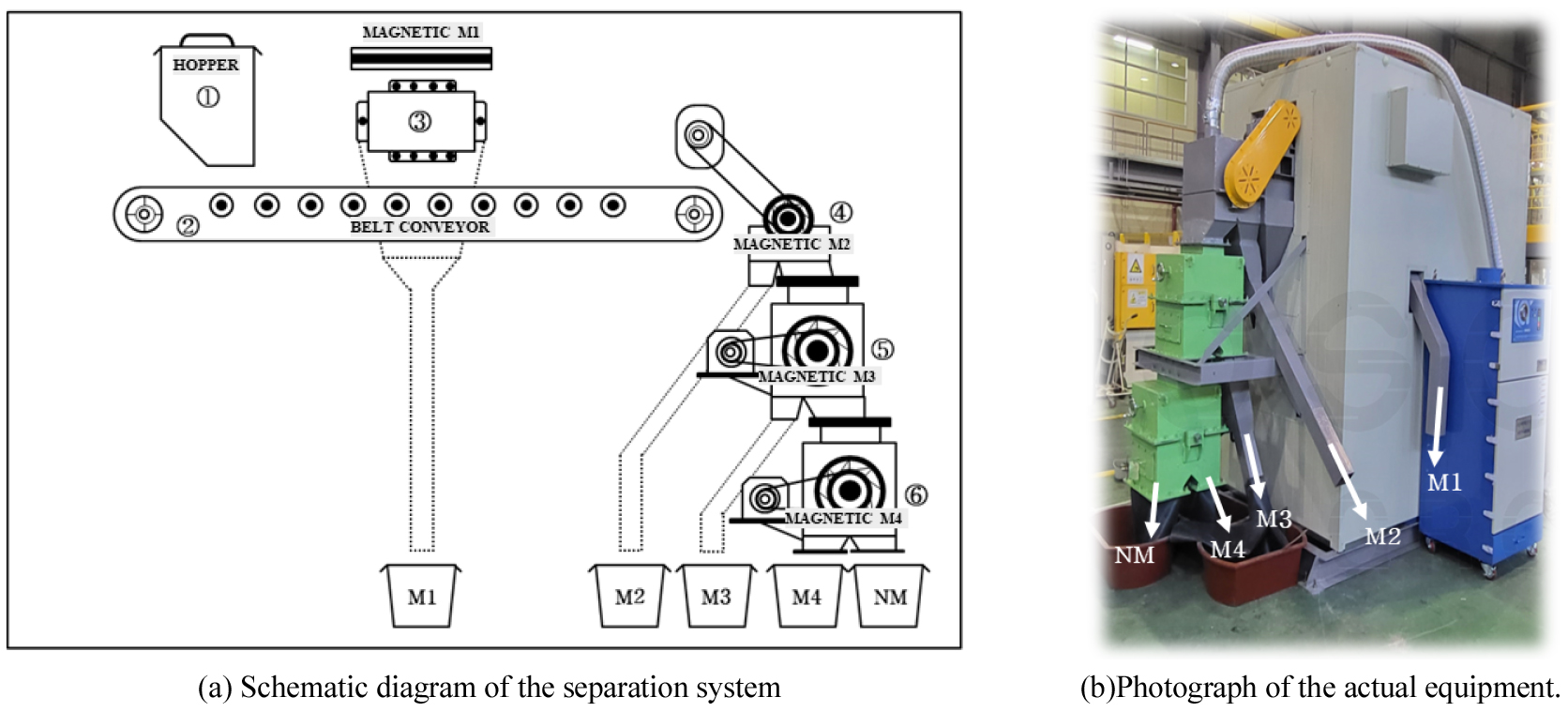
-
A Study on the Separation and Iron Recovery from Steelmaking Slag Using Continuous Multi-Stage Magnetic Separation
연속식 다단 자력선별을 이용한 제강슬래그 선별 및 철원 회수에 관한 연구
-
Seolji Nam, Sungkoo Jo, Hoonha Lee
남설지, 조성구, 이훈하
- In this study, we developed a continuous multi-stage magnetic separation process to reduce greenhouse gas emissions in steelmaking by using weak magnets …
본 연구는 철강 산업에서 발생하는 부산물인 전로슬래그를 효과적으로 자원화하고, 이를 시멘트 산업의 원료로 활용하여 온실가스 배출 저감에 기여하기 위한 방안으로 약자석을 이용한 …
- In this study, we developed a continuous multi-stage magnetic separation process to reduce greenhouse gas emissions in steelmaking by using weak magnets to enhance the resource recovery of slag from a basic oxygen furnace (BOF) for use as a raw material in cement production. This process overcomes the limitations of conventional batch-type magnetic separation with strong magnets by classifying the slag into five fractions (M1–M4 and NM) according to their magnetic properties. The results of an experimental evaluation of the proposed method show that the M1 fraction, containing 89.0 wt% Fe, can serve as a substitute for scrap iron, whereas the M2 fraction, with 46.8 wt% Fe, has potential as a sintering feed. Of note, the NM fraction exhibited a high CaO content of 35.4 wt% and can be used as a substitute for limestone in cement manufacturing. Quantitative and qualitative analyses using 3D X-ray computed tomography confirmed changes in the distribution of Fe before and after magnetic separation, which demonstrates that Fe was recovered efficiently and that the utilization of nonmetallic components added value. These findings indicate that the proposed process is technically feasible as an environmentally beneficial strategy for advanced resource recovery of steelmaking by-products.
- COLLAPSE
본 연구는 철강 산업에서 발생하는 부산물인 전로슬래그를 효과적으로 자원화하고, 이를 시멘트 산업의 원료로 활용하여 온실가스 배출 저감에 기여하기 위한 방안으로 약자석을 이용한 연속식 다단 자력선별 공정을 개발하였다. 기존의 강자석을 이용한 배치식 자력선별 방식의 한계를 개선하기 위해 약자석을 활용하여 슬래그를 M1~M4, NM으로 분류하였다. 실험 결과, M1 시료는 89.0 wt%의 Fe를 포함하여 철스크랩 대체 자원으로 활용 가능하며, M2 시료는 46.8 wt%의 Fe를 함유해 소결 원료로서의 활용 가능성을 확인하였다. 또한 CaO 함량이 35.4 wt%로 높은 NM 시료는 석회석 대체 원료로 시멘트 제조 공정에 활용될 수 있는 가능성을 보였다. 3D X-CT 분석을 통해 자력선별 전후 슬래그 내 Fe 분포의 변화를 정량적, 정성적으로 검증하였으며, 이를 통해 슬래그 내 함유된 철원의 활용과 비금속 자원의 고부가가치화를 동시에 달성할 수 있음을 확인하였다. 따라서 제안된 연속식 다단 자력선별 공정은 제철 부산물의 고도화된 자원화 기술로서 기술, 환경적 측면에서 유의미한 적용 가능성을 제시한다.
-
A Study on the Separation and Iron Recovery from Steelmaking Slag Using Continuous Multi-Stage Magnetic Separation
-
Research Paper
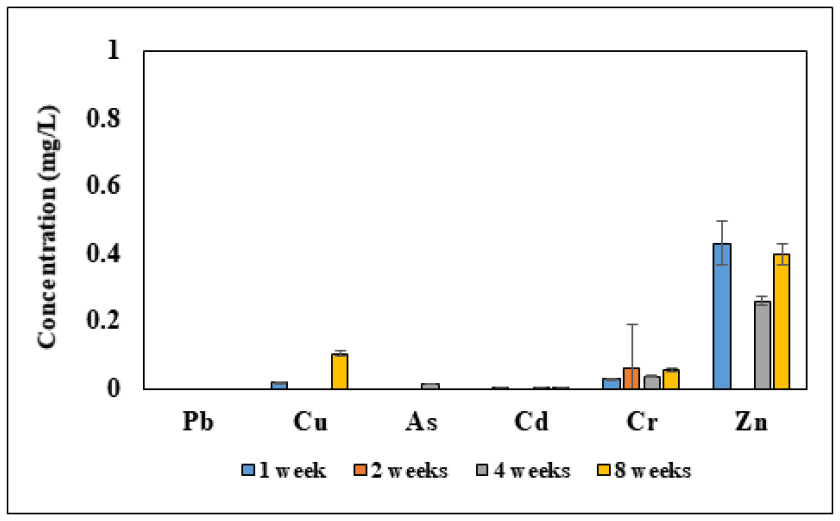
-
Assessment of Long-Term Leaching Characteristics of Mine Backfill Materials
광산용 채움재의 장기간 용출 특성 평가
-
Junbeum Lee, Kyeongmin Kim, Chaehyeon Lee, Min Kyeong Lee, Junghyun Lim, Eunhyea Chung
이준범, 김경민, 이채현, 이민경, 임정현, 정은혜
- This study aims to evaluate the environmental stability of a backfill material composed of fly ash, low-grade limestone, and green cement by …
본 연구는 비산재, 저품위 석회석, 그린시멘트를 혼합한 채움재의 환경 안정성을 단기 및 장기 용출 특성 분석을 통해 평가하였다. 단기 용출시험은 Korean Standard …
- This study aims to evaluate the environmental stability of a backfill material composed of fly ash, low-grade limestone, and green cement by conducting short- and long-term leaching assessments. The short-term leaching tests were based on the Korean Standard Leaching Test(KSLT) and the Toxicity Characteristic Leaching Procedure(TCLP) protocols, and all measured parameters satisfied the leaching standards of the Waste Management Regulation. Although the total Cr and As concentrations exceeded the drinking water quality standards in some samples, this does not indicate regulatory non-compliance for ground backfill, which was assessed against the KSLT/TCLP leaching limits that were met under the test conditions. For long-term behavior prediction, geochemical modeling was performed using pH-Redox-Equilibrium in C programming language(PHREEQC). The leaching concentrations of the major heavy metals(Pb, Cd, Cu, and Zn) were predicted to be below 0.010 mg/L, indicating stable concentrations under highly alkaline conditions. This study provides data supporting the long-term application potential of mine backfill materials that utilize industrial byproducts.
- COLLAPSE
본 연구는 비산재, 저품위 석회석, 그린시멘트를 혼합한 채움재의 환경 안정성을 단기 및 장기 용출 특성 분석을 통해 평가하였다. 단기 용출시험은 Korean Standard Leaching Test(KSLT) 및 Toxicity Characteristic Leaching Procedure(TCLP) 기준에 따라 수행되었으며, 모든 항목이 폐기물관리법상 용출허용기준을 만족하였다. 일부 시료에서 총 Cr과 As가 먹는물 수질기준을 일시적으로 초과하였으나, 이는 음용수 대상이 아닌 지반 채움재로서의 적용을 고려할 때 위해성이 제한적일 수 있다. 장기 거동 예측을 위해 pH-Redox-Equilibrium in C programming language(PHREEQC) 기반 지화학 모델링을 수행한 결과, 주요 중금속(Pb, Cd, Cu, Zn)의 침출 농도는 모두 0.010 mg/L 미만으로 나타났으며, 고알칼리 조건에서 안정적인 농도 유지가 확인되었다. 본 연구는 산업 부산물을 활용한 광산 채움재의 장기간 적용 가능성을 뒷받침하는 자료로 활용될 수 있다.
-
Assessment of Long-Term Leaching Characteristics of Mine Backfill Materials
-
Research Paper
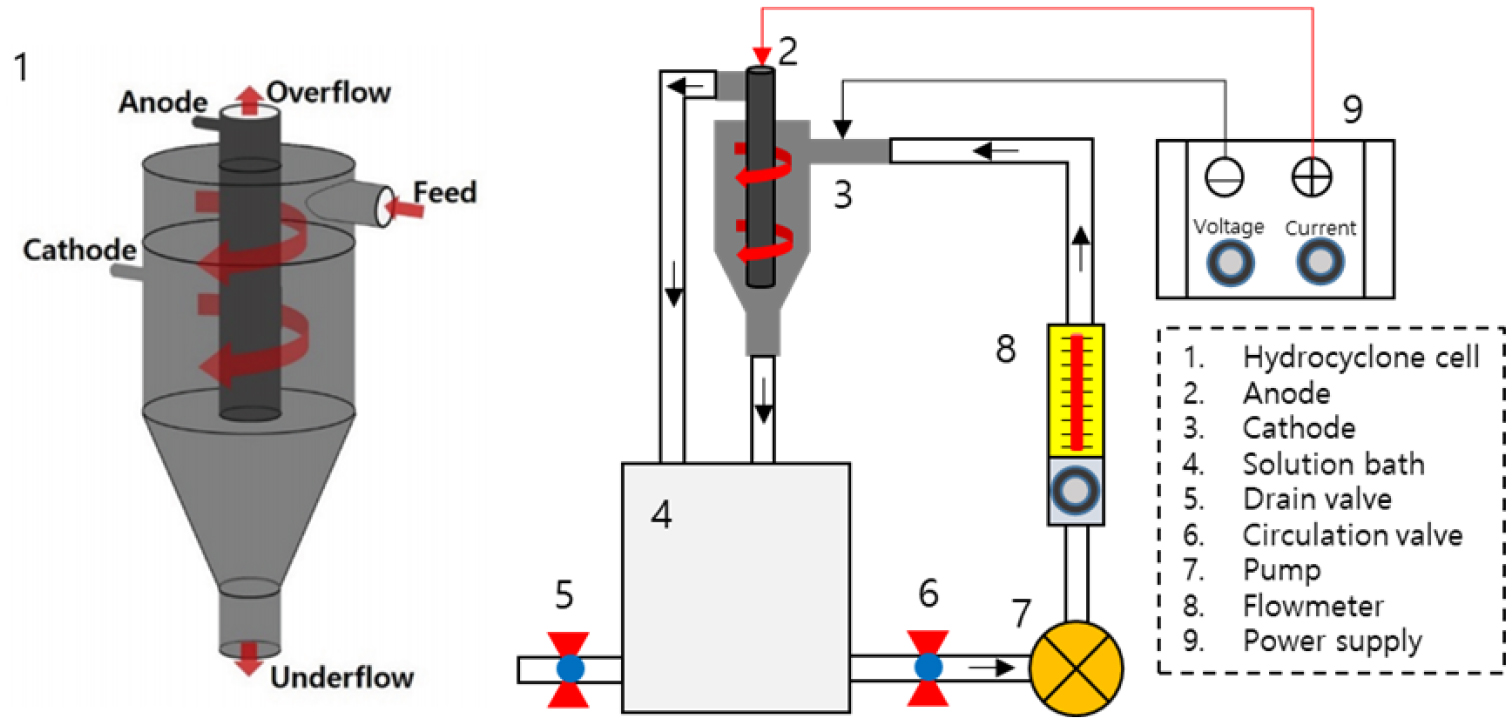
-
Platinum Recycling from Fuel Cell MEA: Application of Oxygen-Free Pyrolysis, Chloride Leaching and Hydro-Cyclone Electrowinning
연료전지 막전극접합체에서의 백금 재자원화: 무산소 열분해, 염산침출, 사이클론 전해채취의 적용
-
Mooki Bae, Hyunju Lee, Sookyung Kim, Jong-Won Choi
배무기, 이현주, 김수경, 최종원
- This study presents an integrated approach for platinum recovery and recycling from spent fuel cell membrane electrode assemblies (MEAs) using oxygen-free pyrolysis, …
본 연구는 연료전지 제조공정에서 발생하는 MEA 폐촉매를 대상으로, 무산소 열분해 전처리-염산 침출-사이클론 전해채취-재활용 전극 제조로 이어지는 통합 백금 회수 및 재자원화 공정을 …
- This study presents an integrated approach for platinum recovery and recycling from spent fuel cell membrane electrode assemblies (MEAs) using oxygen-free pyrolysis, acid leaching, cyclone electrodeposition, and recycled electrode fabrication. Thermogravimetric analysis revealed 500–600°C as the optimal pyrolysis temperature range for effective removal of organics and fixed carbon. MEAs treated at 600°C showed over 71% Pt leaching efficiency (4800 mg/kg) under the following optimal conditions: stirring at 250 rpm, 5 g/L pulp density, 2 vol% H2O2, 6 M HCl, and 90°C. At 1000°C, Pt predominantly formed PtO2, resulting in significantly reduced leaching efficiency owing to a positive Gibbs free energy (ΔG° = +32 kJ/mol) for dissolution in HCl. Cyclone electrowinning enabled rapid and efficient Pt recovery (98% in 120 min at 10 L/min) from dilute leachates. Scanning electron microscopy and X-ray diffraction analyses confirmed that the recovered Pt was highly pure and crystalline. Electrodes fabricated from cyclone-recovered Pt showed superior hydrogen evolution reaction performances compared with that of commercial Pt/C, with a lower overpotential (30 mV at 10 mA/cm2), smaller Tafel slope, and stable operation for 15 h. Overall, this study demonstrates a practical route for the efficient recovery and direct reuse of Pt from waste MEAs, supporting both high-value metal recycling and sustainable electrocatalyst production.
- COLLAPSE
본 연구는 연료전지 제조공정에서 발생하는 MEA 폐촉매를 대상으로, 무산소 열분해 전처리-염산 침출-사이클론 전해채취-재활용 전극 제조로 이어지는 통합 백금 회수 및 재자원화 공정을 제안하고, 각 단계별 효율 및 소재 특성 변화를 체계적으로 평가하였다. TGA 분석 결과, 500~600°C 부근에서 MEA 내 유기물과 고정탄소가 효과적으로 제거됨을 확인하여 열처리 조건으로 선정하였다. 600°C에서 열처리한 MEA 시료의 백금 침출 실험에서는, 교반속도 250 rpm, 광액농도 5 g/L, H2O2 2 vol%, 염산 6 M, 90°C 등 최적 조건에서 약 71% 이상의 침출 효율(4800 mg/kg)이 나타났다. 고온(1000°C) 열처리 시 백금이 주로 PtO2 형태로 변환되어, 염산 침출에서 ΔG°가 양수(+32 kJ/mol)로 전환됨에 따라 침출 효율이 현저히 저하되는 현상도 관찰되었다. 침출액 내 저농도 백금 회수를 위해 적용한 사이클론 전해채취 공정에서는 유량 10 L/min 조건에서 120분 이내에 98% 이상의 백금 회수 효율을 달성할 수 있었다. 전해로부터 회수된 백금은 XRD 및 SEM 분석을 통해 고순도, 결정성 금속 상태임이 확인되었다. 제조된 Cyclone Pt/C 전극은 상용 Pt/C 전극 대비 10 mA/cm2에서 더 낮은 과전압(30 mV), 더 작은 Tafel slope, 장시간(15시간) 내구성 유지 등 수소 발생 전극 촉매로서 뛰어난 성능과 안정성을 보였다. 이러한 결과는 폐 연료전지 MEA로부터 백금을 효율적으로 회수·재활용할 수 있는 실질적 공정 경로를 제시하며, 고부가가치 귀금속 자원순환 및 친환경 촉매 제조 분야에 기여할 수 있음을 시사한다.
-
Platinum Recycling from Fuel Cell MEA: Application of Oxygen-Free Pyrolysis, Chloride Leaching and Hydro-Cyclone Electrowinning
-
Research Paper

-
Analysis of the Characteristics of Waste Plastic in Domestic Cement Plant and Clinker Using Waste Plastic
국내 시멘트 공장의 폐합성수지 및 이를 사용한 클링커 특성 분석
-
Jung Hwan Bang, Young Jun Lee, Do Young Kwon, Yong Sik Chu
방정환, 이영준, 권도영, 추용식
- Waste plastic used in domestic cement plant(A~C) were obtained in this study. The properties of waste plastic and clinker using waste plastic …
본 연구에서는 국내 시멘트 공장(A~C 공장)에 투입되는 폐합성수지를 입수하여, 폐합성수지의 자체 특성과 폐합성수지 사용 클링커의 특성을 분석하였다. 이때 폐합성수지는 발열량과 열분해 특성을, …
- Waste plastic used in domestic cement plant(A~C) were obtained in this study. The properties of waste plastic and clinker using waste plastic were analyzed. The calorific value and thermal decomposition characteristics of waste plastic were analyzed, and the burnability, crystallinity, and microstructure of clinkers were analyzed. The calorific value of waste plastic ranged from 6,400 to 13,500 kcal/kg. The PVC-containing waste plastic from B plant had a relatively low calorific value(approximately 6,400 kcal/kg). The waste plastic did not completely combust at high temperature, and approximately 20 to 30% residues remained. The burnability index of clinker using 3 to 9% waste plastic slightly increased compared to Ref. value. The four major clinker minerals using 3 to 9% waste plastic were detected at similar levels to those of Ref., and the sizes of alite and belite were also similar to those of Ref. It was confirmed that the clinker properties did not change even when using up to 9% waste plastic.
- COLLAPSE
본 연구에서는 국내 시멘트 공장(A~C 공장)에 투입되는 폐합성수지를 입수하여, 폐합성수지의 자체 특성과 폐합성수지 사용 클링커의 특성을 분석하였다. 이때 폐합성수지는 발열량과 열분해 특성을, 클링커는 소성성, 결정성 및 미세구조 등을 분석하였다. 국내 폐합성수지의 발열량은 6,400~13,500kcal/kg이었으며, B 공장의 폐합성수지는 PVC가 혼입되어 상대적으로 낮은 발열량을(약 6,400kcal/kg) 나타내었다. 폐합성수지는 고온에서 전량 연소되지 않고, 약 20~30%의 잔존물이 존재하였다. Ref. 대비 폐합성수지 3~9% 연소 클링커의 소성성 지수는 소폭 상승하였다. 폐합성수지 3~9% 연소 클링커는 클링커 4대 광물이 Ref.와 유사 수준으로 검출되었으며, alite 및 belite 크기도 Ref.와 유사하였다. 따라서 폐합성수지를 9%까지 사용하여도 클링커 물성이 변화되지 않는다는 것을 확인할 수 있었다.
-
Analysis of the Characteristics of Waste Plastic in Domestic Cement Plant and Clinker Using Waste Plastic
-
Research Paper
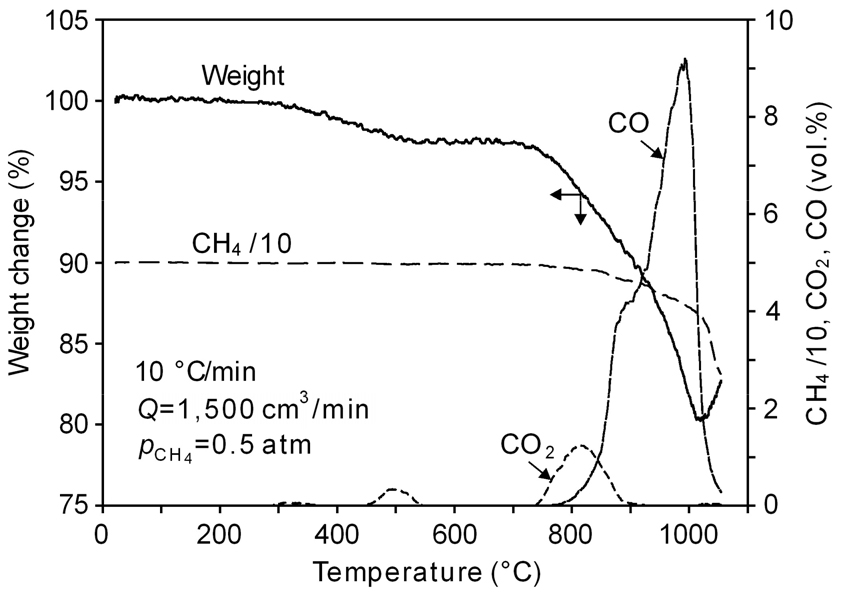
-
Reduction Roasting of Black Mass Recovered from NCM-based Spent Lithium-ion Batteries Using CH4 Gas
NCM계 폐리튬이온 배터리에서 회수한 Black Mass의 CH4 가스에 의한 환원배소
-
Sang-Yeop Lee, Jae-Ho Hwang, Ho-Sang Sohn
이상엽, 황재호, 손호상
- In this study, the effect of temperature on the reduction roasting by CH4(g) of the black mass (B/M) recovered from …
본 연구에서는 NCM(LiNixCoyMn1–x–yO2)계 폐리튬이온배터리에서 회수한 black mass(B/M)의 CH4(g)에 의한 …
- In this study, the effect of temperature on the reduction roasting by CH4(g) of the black mass (B/M) recovered from NCM (LiNixCoyMn1–x–yO2)-based spent lithium-ion batteries was investigated through thermogravimetric analysis, exhaust gas analysis, and X-ray diffraction analysis of the products. When the B/M sample was subjected to thermogravimetric analysis up to 1,100 °C in a 50 vol.% CH4(g)+Ar atmosphere, the sample weight decreased rapidly from about 760 °C and then increased again from about 1,020 °C. At this time, CO(g) reached its maximum value and then decreased rapidly. This rapid decrease in sample weight is thought to be largely due to the contribution of C solution loss caused by the Boudouard reaction. In the isothermal reduction 713 ℃~1,000 ℃), CO2(g) and CO(g) were generated before CH4(g) supply, and the sample weight began to decrease. With the supply of CH4(g), the sample weight further decreased, reaching the minimum value before increasing significantly again, and at 1,000°C, it showed a value much higher than the weight of the original sample weight. Regardless of the reduction roasting temperature, oxides such as Ni and Co were reduced, and the Li recovery rate was approximately 87% or higher, independent of the isothermal roasting temperature. At 802 °C and 908 °C, LiOH was also detected, suggesting that the cathode material was reduced by H2(g) through the thermal decomposition of CH4(g).
- COLLAPSE
본 연구에서는 NCM(LiNixCoyMn1–x–yO2)계 폐리튬이온배터리에서 회수한 black mass(B/M)의 CH4(g)에 의한 환원배소에 미치는 온도의 영향을 열중량 분석과 배가스 분석 및 생성물의 X-선 회절분석을 통하여 조사하였다. B/M 시료를 50 vol.%CH4(g)+Ar 분위기에서 1,100 ℃까지 열중량 분석했을 때 시료의 무게가 약 760 ℃부터 급격히 감소한 후 약 1,020 ℃부터 다시 증가하였으며, 이 때 CO(g)는 최곳값을 보인 후 급격하게 감소하였다. 이러한 시료 무게의 급격한 감소는 부도아 반응에 의한 C solution loss의 기여가 큰 것으로 생각된다. 등온 배소(713 ℃~1,000 ℃)에서는 CH4(g) 공급 전에 CO2(g)와 CO(g)는 발생하면서 시료의 무게도 감소하기 시작하여 CH4(g) 공급과 함께 시료 무게가 더욱더 감소하여 최솟값을 보인 후 다시 현저하게 증가하여 1,000 ℃에서는 원시료 무게보다 훨씬 높은 값을 나타내었다. 환원배소 온도와 무관하게 Ni, Co 등의 산화물이 환원되어 Li 회수율은 등온배소 온도와 무관하게 약 87 % 이상을 나타내었다. 802 ℃와 908 ℃에서는 LiOH도 검출되어 CH4(g)의 열분해에 의한 H2(g)에 의해 양극재의 환원이 일어난 것으로 생각된다.
-
Reduction Roasting of Black Mass Recovered from NCM-based Spent Lithium-ion Batteries Using CH4 Gas
-
Research Paper
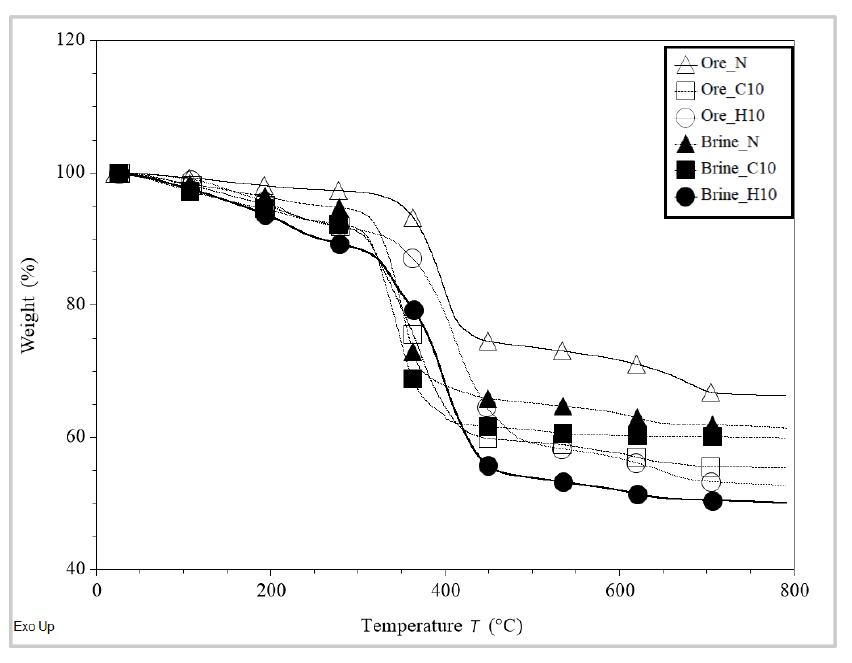
-
Evaluation of Applicability of Magnesium-Based CO2 Capture Specimens Derived from Brine
간수에서 회수한 마그네슘을 활용한 이산화탄소 포집체로서의 적용성 평가
-
Junhyeon Cho, Kyungha Kang, Hongseok Jang
조준현, 강경하, 장홍석
- In this study, a CO2-sequestering specimen was fabricated and evaluated based on MgO obtained from the recovery and calcination of …
본 연구에서는 간수에서 pH swing 법을 활용하여 마그네슘을 회수하고 이를 소성하여 얻은 산화마그네슘을 기반으로한 이산화탄소 포집형 시험체를 제작 및 평가하였다. 브루사이트 광석을 …
- In this study, a CO2-sequestering specimen was fabricated and evaluated based on MgO obtained from the recovery and calcination of magnesium from brine using a pH swing method. Brucite ore was used as the control. MgO was synthesized through calcination at 500 °C. The reactivity of the synthesized MgO was measured using acetic acid and citric acid methods and exhibited reaction times of 12, 24, 75, and 183s, indicating high reactivity. Subsequently, accelerated carbonation curing was performed using sodium bicarbonate as a carbonation accelerator. X-ray diffraction and Simultaneous Differential Scanning Calorimetry and Thermogravimetric Analyses of the cured specimens revealed the formation of magnesium carbonate phases in the specimens with sodium bicarbonate, which were absent in the specimens without sodium bicarbonate. Moreover, weight loss increased in the approximate range of 300-500°C, confirming enhanced CO2 sequestration. These results are expected to serve as fundamental data for the resource utilization of bitterns and desalination brines in future applications.
- COLLAPSE
본 연구에서는 간수에서 pH swing 법을 활용하여 마그네슘을 회수하고 이를 소성하여 얻은 산화마그네슘을 기반으로한 이산화탄소 포집형 시험체를 제작 및 평가하였다. 브루사이트 광석을 대조군으로 선정하고 간수에서 얻은 수산화마그네슘과 500 ℃로 소성하여 산화마그네슘을 합성하였다. 수득한 산화마그네슘의 반응성 시험을 아세트산과 시트르산을 활용하여 측정하였으며 각각 12초, 24초, 75초, 183초가 소요되어 높은 반응성을 갖는 것으로 나타났다. 이후, 탄산 촉진제인 중탄산나트륨을 혼입하여 촉진 탄산화 양생을 수행하였다. 양생이 완료된 시험체를 XRD, SDT 분석을 수행하였으며 탄산 촉진제가 첨가되지 않은 시험체에 비해 탄산 촉진제가 첨가된 시험체에서 탄산마그네슘 결합체의 결정을 확인하였고, 300-500 ℃ 구간의 중량감소율이 증대되어 이산화탄소 포집이 개선된 것을 확인하였다. 향후, 간수 및 해수담수화 폐수의 자원화 과정의 기초 자료로 활용될 것으로 기대된다.
-
Evaluation of Applicability of Magnesium-Based CO2 Capture Specimens Derived from Brine



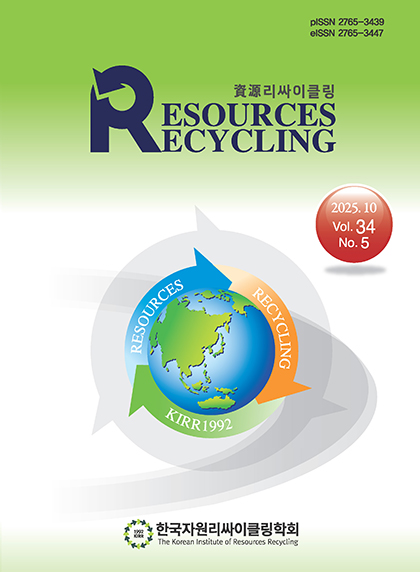 Resources Recycling
Resources Recycling



